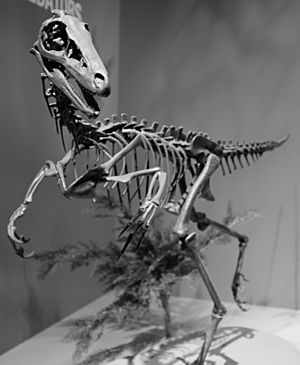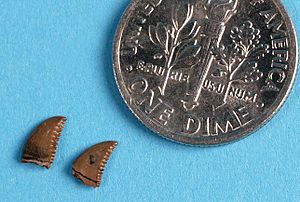Troodon facts for kids
Quick facts for kids TroodonTemporal range: Late Cretaceous, 77.5–76.5 mya
|
|
|---|---|
 |
|
| Illustration of the T. formosus holotype tooth | |
| Scientific classification |
|
| Kingdom: | Animalia |
| Phylum: | Chordata |
| Clade: | Dinosauria |
| Clade: | Saurischia |
| Clade: | Theropoda |
| Family: | †Troodontidae |
| Subfamily: | †Troodontinae Gilmore, 1924 |
| Genus: | †Troodon Leidy, 1856 |
| Type species | |
| †Troodon formosus Leidy, 1856
|
|

Troodon (say "TROH-oh-don") was a type of small, bird-like dinosaur. It lived during the later part of the Cretaceous period, about 75 to 65 million years ago. The name Troödon helps us know that the two "o" letters are pronounced separately, like in the word "zoology."
These dinosaurs were probably meat-eaters, also known as carnivores. However, their teeth were a bit unusual. Some scientists think they might have eaten plants too, but most experts believe they mainly ate meat.
Contents
Discovering Troodon
Troodon was first found in central Montana in 1855. It was one of the first dinosaurs ever discovered in North America. Troodon fossils have been found in many places. They lived as far north as Alaska and Alberta, Canada. They also lived as far south as Wyoming and possibly even Texas and New Mexico.
What Troodon Looked Like
Troodon had a large brain compared to its body size. It also had a special "sickle claw" on its second toe. This claw was big and could be pulled back, like a cat's claw. Troodon had 122 teeth in its mouth.
Scientists can tell from their leg bones that Troodon was a very fast runner. The sickle claw and its good binocular vision (meaning it could see depth well) suggest that Troodon was a skilled hunter.
Size Differences
The size of Troodon varied a lot depending on where they lived. Troodon that lived in colder, northern areas were usually bigger. For example, Troodon in Alaska could be up to 12 feet long and 5 feet tall. They could weigh up to 175 pounds!
However, Troodon that lived in warmer, southern places were smaller. They were only about 7 feet long and 3 feet tall. These smaller Troodon weighed around 50 pounds, similar to the size of a Velociraptor. Scientists believe Troodon likely had feathers, but no fossil evidence of feathers has been found yet.
Troodon Nests and Babies
Scientists have found Troodon nests full of eggs in Montana. When they used special scanners, they found tiny baby Troodon skeletons inside the eggs!
They also found skeletons of a small plant-eating dinosaur called Orodromeus near the eggs. At first, people thought the eggs belonged to Orodromeus. They thought the adult Troodon was trying to steal the eggs.
But once the baby Troodon embryos were found inside the eggs, it became clear the eggs belonged to Troodon. Now, scientists think the adult Troodon had hunted the Orodromeus. They likely brought them back to the nest to feed their own babies.
Troodon laid up to 24 eggs in their nests. These nests were usually mounds of earth. They could lay two eggs at a time. This means it would take about two weeks to lay a very large clutch of eggs.
Images for kids
-
Comparison of troodontid teeth; A is the T. formosus holotype
See also
 In Spanish: Troodon formosus para niños
In Spanish: Troodon formosus para niños


